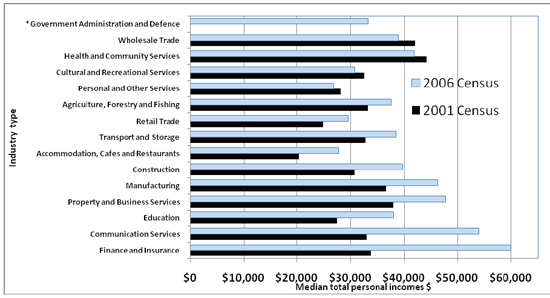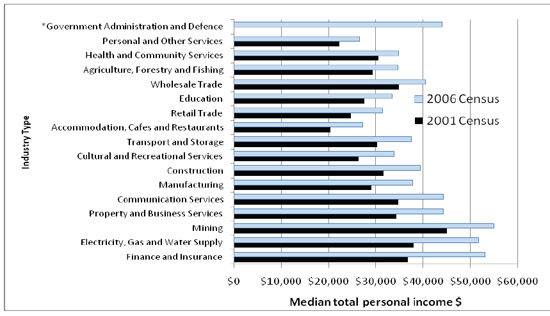
Tirohanga Ohanga mō Te Moana a Toi: Māori Entrepreneurs in Te Moana ā Toi and New Zealand for 2001 and 2006
Table of contents
- Foreword
- Key Facts
- Defining and Measuring Entrepreneurship
- Māori Entrepreneurship in New Zealand and the Bay of Plenty Region, for 2001 and 2006
- Purpose of the Report
- Background
- Methodology
- New Zealand's Growth of the Māori Workforce and Entrepreneurs
- Increase in the Proportion of Māori Female Entrepreneurs
- Entrepreneurs Per Region
- Focus on Industries
- Māori Entrepreneurs in the Bay of Plenty Region by Industry (Full-time)
- Māori Entrepreneurs (Full-time) Median Total Personal Income in the Bay of Plenty Region
- Highest Qualification
- Technical Notes
- Appendices
- References
- Disclaimer and Copyright
Māori Entrepreneurs (Full-time) Median Total Personal Income in the Bay of Plenty Region
Graph 4: Māori Entrepreneurs1 Employed Full-time2 Aged 15 Years and Over, Median Total Personal Incomes3 for the Bay of Plenty Region4 by Industry Type5 for 2001 and 2006 Censuses.

Source: Statistics New Zealand’s 2001 and 2006 Censuses. *Excludes 2001 data for Government Administration and Defence industry due to Statistics New Zealand’s confidentiality rules applied to low numbers.
Note: The mining; and Electricity, Gas and Water industry data for both 2001 and 2006 has been excluded due to Statistics New Zealand’s confidentiality rules applied to low numbers.
All data relates to the employed working age population aged 15 years and over, and those people working 30 hours or more per week (full-time).
1 = Entrepreneurs used this report includes: Māori employers and Māori self-employed and without employees.
2 = Employed includes: Full-time and Part-time employed. Full-time is equal to people working 30 or more hours per week. Also, employed is related to work in the 7 days prior to 6 March 2001 and 5th March 2006. The analysis shown in tables and graphs is for the job a person worked the most hours in.
3 = Information on total personal income received was collected from individuals in the 2001 and 2006 Censuses. It represents the before-tax income for the respondent in the 12 months ending 31 March 2006 and 2001. Dollar amounts shown are not inflation-adjusted. Note: The data shown in this graph is for median total personal income. The median income is the amount where half earn more, and half earn less than this amount, rounded to the nearest $100.
4 = the Bay of Plenty region refers to the Bay of Plenty regional council and includes the following areas: Taupo District; Western Bay of Plenty District, Tauranga City, Rotorua District, Whakatane District, Kawerau District, and Opotiki District.
5 = ANZSIC is the Australian and New Zealand Standard Industrial Classification. The ANZSIC96 version used for this analysis is version 4.1.
Graph 4 above shows the median personal income of full-time Māori entrepreneurs by industry type for the Bay of Plenty region for both 2001 and 2006. The median income is the amount where half earn more, and half earn less than this amount, rounded to the nearest $100.
Graph 4 for 2006 shows the median total personal incomes that full-time Māori entrepreneurs in the following three industries received21:
- Finance and insurance at $60,000;
- Communication services at $54,000; and
- Property and business services at $47,800.
Similarly for 2001, the median total personal incomes of full-time Māori entrepreneurs in the following three industries22:
- Health and community services at $44,300;
- Wholesale trade at $42,000; and
- Property and business Services at $38,000.
Moreover, the following four industries have shown the largest increases in median total personal incomes for full-time Māori entrepreneurs from 2001 and 2006:
- Finance and insurance at 77.5%;
- Communication services at 63.6%;
- Education at 38.5%; and
- Accommodation, cafes and restaurants at 36.3%.
New Zealand Median Total Personal Income23
See graph 5 below, for New Zealand in 2006, Māori entrepreneurs working in the mining industry had a higher median income than those working in other industries. The median personal income of Māori in this group was $55,000 compared to the national median of $36,300 for all Māori entrepreneurs. The industries with the next highest median personal incomes were the finance and insurance industry, at $53,100, and the electricity, gas and water supply industry, at $51,700.
From 2001 and 2006, the median personal income of all Māori entrepreneurs increased by $7,800 or 27.4%. The three industries with the biggest percentage increases were:
- Finance and insurance, at 44.7%;
- Electricity, gas and water supply, at 36.4%; and
- Accommodation, cafes and restaurants, at 34.0%.
Graph 5: Māori Entrepreneurs for New Zealand by Median Total Personal Income for 2001 and 2006 24 Censuses.

Source: Statistics New Zealand’s, Census of Population and Dwellings, 2001 and 2006.
*Government Administration and Defence industry data was excluded for 2001 because of Statistics New Zealand’s confidentiality rules.
This figure uses data for the employed people aged 15 years of age and over, who worked part-time and full-time.
ANZSIC is the Australian and New Zealand Standard Industrial Classification. The ANZSIC96 version used for this analysis is version 4.1.
21 Although income data is collected for all sources, not just the main job of the individual and therefore cannot necessarily be attributed to the industry they working in. For example, some entrepreneurs may get some of their income from investments rather than the industry in which they are working. In other words, part of a person’s income may not necessarily come from their industry of employment, but maybe sourced from somewhere else.
22 Note: Due to Statistics New Zealand’s confidentiality provisions we do not have 2001 data for the following three industries: Mining; Electricity, Gas and Water supply; and Government Administration and Defence.
23 Median income is the amount where half earn more, and half earn less than this amount, rounded to the nearest $100.
24 Please refer to Confidentiality Rules under Technical Notes regarding data that is not shown in Graph 7.